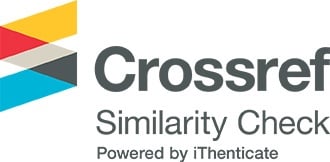Điều trị viêm xương khớp ở khớp thái dương hàm: Báo cáo ca lâm sàng
Các tác giả
Từ khóa:
viêm xương khớp ở khớp thái dương hàm, rối loạn khớp cắn, cản trở cắn khớpTóm tắt
Giới thiệu: Viêm xương khớp ở khớp thái dương hàm gây ra các thay đổi vĩnh viễn trên cấu trúc xương của khớp, đau, và giới hạn vận động hàm. Nghiên cứu này nhằm chứng tỏ hiệu quả của các phương thức điều trị không xâm lấn trên viêm xương khớp tiến triển và việc loại bỏ cản trở cắn khớp gây quá tải lực lên khớp trong việc trì hoãn sự tiến triển bệnh. Vật liệu và phương pháp: Bài báo này mô tả trường hợp bệnh nhân nữ 42 tuổi đau ở vùng trước tai, má, cổ và vai phải. Bệnh nhân được chẩn đoán viêm xương khớp khớp thái dương hàm phải, thoái hóa khớp trái; đồng co cơ bảo vệ ở cơ cắn, cơ thang phải; và rối loạn khớp cắn (Cắn sâu 100%, mòn nhiều các răng trước do tiếp xúc không ổn định ở vùng răng trước). Điều trị ban đầu với các phương thức không xâm lấn, sau đó phục hình cố định trên các răng dưới có nâng kích thước dọc ở tương quan trung tâm để tạo tiếp xúc ổn định cho khớp cắn. Kết quả và kết luận: Các phương thức điều trị không xâm lấn giúp loại bỏ đau, tăng độ há miệng. Phục hình cố định giúp tạo tiếp xúc khớp cắn ổn định, bệnh nhân ăn nhai thoải mái hơn, và tình trạng bệnh được kiểm soát trong một thời gian dài.
Abstract
Introduction: Temporomandibular joint osteoarthritis causes permanent changes in the bony structure of the joint, pain and limits jaw mobility. This study aims to demonstrate the efficacy of (1) non-invasive treatment modalities in progressive osteoarthritis, and (2) the removal of occlusal interferences that cause excessive force on the joint in delaying disease progression. Materials and Methods: This article describes the case of a 42-year-old female patient, with pain in front of the right ear, cheek, neck, and shoulder. The diagnoses were osteoarthritis in the right temporomandibular joint, osteoarthrosis in the left joint, protective co-contraction in the right masseter and trapezius muscle; and occlusal disorder (100% deep bite, severe anterior tooth wear due to unstable contacts in the anterior teeth). Initial treatment with non-invasive modalities, followed by fixed restorations on the lower teeth with 1mm vertical dimension increase in centric relation to provide stable occlusal contacts. Results and conclusion: Non-invasive treatment methods helped to eliminate pain and increase the range of opening. Fixed restorations in the lower jaw created stable tooth contacts, the patient’s chewing has been more comfortable, and the condition was controlled for a long time.
Tài liệu tham khảo
[1] S. Grässel and D. Muschter, “Recent advances in the treatment of osteoarthritis [version 1; peer review: 3 approved]”, F1000 Research 2020, 9(F1000 Faculty Rev: 325. doi.org/10.12688/f1000research.22115.1
[2] Z. Al-Ani, “Temporomandibular Joint Osteoarthrosis: a review of clinical aspects and management”, Prim Dent J.,10, 1, 132-140, 2021.
[3] J.P. Okeson, Management of temporomandibular disorders and occlusion, 8ed. Elsevier Inc, 2019.
[4] D. Manfredini, Current concepts on temporomandibular disorders. Quintessence Publishing Co. Ltd, 2010.
[5] A. Alzahrani, S. Yadav, V. Gandhi, A.G. Lurie, and A. Tadinada, “Incidental findings of temporomandibular joint osteoarthritis and its variability based on age and sex”, Imaging Science in Dentistry, 50, 245-53, 2020.
[6] M. Derwich, M. Mitus-Kenig and E. Pawlowska, “Interdisciplinary Approach to the Temporomandibular Joint Osteoarthritis-Review of the Literature”, Medicina, 56, 225, 2020. doi:10.3390/medicina56050225.
[7] M. Wu, J. Cai, Y. Yu, S. Hu, Y. Wang and M. Wu, “Therapeutic Agents for the Treatment of Temporomandibular Joint Disorders: Progress and Perspective”, Frontiers in Pharmacology, Volume 11, 2021, Article 596099. DOI: 10.3389/fphar.2020.596099.
[8] J.D. Orthlieb., T.T.N. Ny, A. Camoin and B. Mantout, “Propositions for a cognitive behavioral approach to bruxism management”, J. Stomat. Occ. Med., 6, 6-15, 2013.
[9] E. Schiffman, R. Ohrbach, E. Truelove, … and S.F. Dworkin, “Diagnostic criteria for temporomandibular disorders (DC/TMD) for clinical and research applications: Recommendations of the International RDC/TMD. Consortium Network and Orofacial Pain Special Interest Group”, J Oral Facial Pain Headache, 28, 1, 6-27, 2014. doi: 10.11607/jop.1151.
[10] K.J. Jeon, C. Lee, Y.J. Choi and S.S. Han, “Comparison of the Usefulness of CBCT and MRI in TMD Patients according to clinical symptoms and age”, Applied Sciences,10, 3599, 2020.
[11] P.E. Dawson, Functional occlusion from TMJ to smile design. Mosby, Inc., 2007.
[12] S.T. Connelly, G.M. Tartaglia, and R.G. Silva, Contemporary management of temporo-mandibular disorders. Springer, 2019.
Tải xuống
Tải xuống: 169







